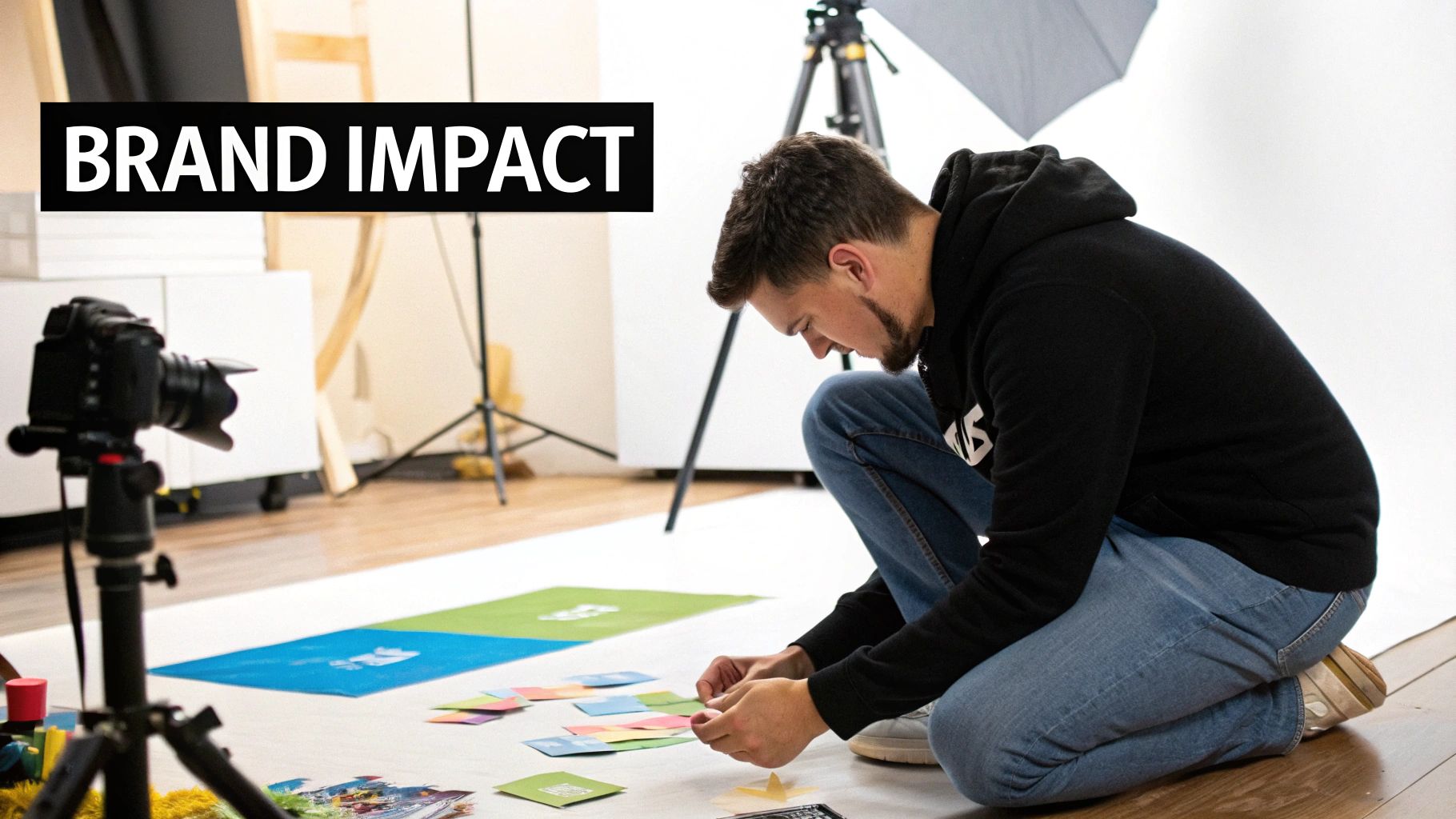The Rise of the Creative Entrepreneur

The creative world is changing. The lines between art and business are blurring, creating exciting new opportunities. This shift has led to the rise of the creative entrepreneur.
These individuals combine artistic talent with sharp business skills. They understand that creativity is not just about self-expression. It's about finding solutions and creating value in a market that prioritizes experiences.
Identifying Opportunities in the Creative Economy
Independent musicians are a great example. They use platforms like Spotify and Bandcamp to connect with fans globally, bypassing traditional record labels. Graphic designers, too, are finding new freedom. They can build their own brands and work directly with clients around the world, skipping the traditional agency route.
This direct connection with consumers allows creative entrepreneurs to build strong relationships and loyal communities. This leads to a more sustainable and rewarding career path. You can explore more creative resources here: Creativize Sitemap
The creative industry is booming. In 2022, the global market was valued at USD 2,669,224.0 million. It’s projected to reach USD 3,434,322.0 million by 2031, growing at a CAGR of 4.29%. The creative economy contributes about 6% to the global GDP and is growing twice as fast as the traditional economy. This rapid growth shows how important creative entrepreneurs are for economic development. Want more statistics? Check out: Creativity Statistics
To illustrate the growth in different creative sectors, take a look at the table below. It highlights market sizes, growth rates, and key opportunities.
Creative Industry Growth by Sector
| Industry Sector | Market Size (millions USD) | Growth Rate | Key Opportunity Areas |
|---|---|---|---|
| Digital Media & Design | 1,200,000 | 6.5% | Mobile app development, UX/UI design, digital marketing |
| Film & Video Production | 500,000 | 5.2% | Streaming content creation, animation, VFX |
| Music & Performing Arts | 400,000 | 4.8% | Online music distribution, virtual concerts, music licensing |
| Publishing & Literature | 300,000 | 3.9% | E-books, self-publishing, content marketing |
| Visual Arts & Crafts | 269,224 | 4.1% | Online art sales, personalized crafts, art licensing |
As you can see, the digital media and design sector is currently the largest and fastest-growing, presenting significant opportunities for creative entrepreneurs. However, all sectors show promising growth, indicating a thriving creative economy.
Key Traits of a Successful Creative Entrepreneur
Talent alone isn't enough. Successful creative entrepreneurs share a unique blend of skills and mindset.
- Adaptability: They're constantly learning and evolving to stay ahead of the curve.
- Resilience: They bounce back from setbacks and see challenges as opportunities to grow.
- Self-Promotion: They know how to communicate their value and build a strong personal brand.
This combination of art and entrepreneurship is highly valuable. Consumers want authentic experiences and unique products. This creates amazing opportunities for those who can deliver. This demand fuels growth in sectors like design, music, film, and even culinary arts.
Creative entrepreneurs are not only boosting the economy but shaping culture and influencing how consumers behave. By connecting with audiences emotionally through their work, they are powerful forces in today's market.
Developing the Creative Entrepreneur Mindset

The vibrant world of a creative entrepreneur isn't solely about artistic brilliance. It requires a unique mindset – a fusion of artistic passion and entrepreneurial spirit. This mindset allows creatives to navigate the business world while staying true to their artistic vision. This section explores the psychological frameworks that separate thriving creative entrepreneurs from those who struggle.
Embracing Resilience and Overcoming Challenges
A key characteristic of successful creative entrepreneurs is their resilience. The creative path is filled with hurdles, from rejection to unpredictable markets. It's vital to view these setbacks not as failures, but as opportunities for growth.
This resilience allows creative entrepreneurs to adapt, learn, and improve their approach, ultimately strengthening their businesses. For example, a musician rejected by a record label might use online platforms like Bandcamp to connect directly with fans. This adaptability is essential for navigating the ever-changing creative industries.
Developing a strong mindset is also critical. Learn more about entrepreneurial mental health. This involves cultivating self-belief, managing self-doubt, and maintaining momentum even when facing obstacles.
Cultivating a Growth Mindset
This resilience often comes from a growth mindset. Creative entrepreneurs with this mindset believe their abilities can be developed through dedication and hard work. They embrace challenges as learning experiences.
This contrasts with a fixed mindset, where individuals believe their talents are innate and unchangeable. A growth mindset allows creative entrepreneurs to constantly refine their skills, experiment, and achieve greater success. This positive approach fuels continuous innovation.
Interestingly, entrepreneurs are often driven by a desire for innovation and autonomy. Around 70% of entrepreneurs start businesses for a career or lifestyle change. In addition, 74% of small and medium business owners are willing to take significant risks to succeed. This highlights the resilience and adaptability within the creative entrepreneurial spirit. Find more detailed statistics here.
Practical Techniques for Mindset Mastery
Developing a creative entrepreneurial mindset takes deliberate effort. Here are some practical techniques:
-
Silencing Imposter Syndrome: Acknowledge self-doubt, but don't let it control you. Focus on your accomplishments and celebrate your progress.
-
Setting Boundaries: Protect your creative energy by setting clear boundaries between your professional and personal life. This helps prevent burnout and allows time to recharge.
-
Building a Support Network: Connect with other creative entrepreneurs for encouragement, advice, and shared experiences. This can provide invaluable support during difficult times.
These practices help creative entrepreneurs maintain a healthy balance between their passion and the demands of running a business. This balance is essential for long-term success and fulfillment.
Crafting Your Creative Business Blueprint

A fulfilling career as a creative entrepreneur takes more than just artistic talent. It requires a solid business foundation. This means leaving behind the "starving artist" myth and embracing a business model that fuels your creative vision. This section explores the essential business frameworks that empower creative entrepreneurs to thrive.
Defining Your Unique Value Proposition
The first step in building a successful creative business is identifying your unique value proposition. This is what sets you apart. It's the unique blend of your skills, perspective, and style. What makes your work special? What problems do you solve for your clients?
For example, a photographer might specialize in capturing the raw emotion of live music. A graphic designer might focus on creating branding materials with a vintage aesthetic. This distinct value proposition helps you target a specific niche and attract clients who resonate with your style. This focused approach is much more effective than trying to be everything to everyone.
Exploring Revenue Models
Once you've defined your value proposition, you need to figure out how you'll generate revenue. There are many revenue models for creative entrepreneurs, each with its own pros and cons. To help illustrate these different approaches, we've created a comparison table outlining some key considerations.
The table below, "Revenue Models for Creative Entrepreneurs", provides an overview of different business models and revenue streams available, along with the pros and cons of each approach. This will help you determine which model, or combination of models, best suits your individual needs and goals.
| Revenue Model | Best For | Initial Investment | Scalability | Time Commitment |
|---|---|---|---|---|
| Freelancing/Client Work: Providing services to clients on a project basis | Building a portfolio, diverse experience | Low | Moderate | Variable, project-dependent |
| Selling Products: Creating and selling physical or digital products (e.g., art prints, online courses) | Reaching a wider audience, passive income | Moderate | High | Significant upfront, then potentially passive |
| Licensing: Granting permission to use your work in exchange for royalties | Leveraging existing work, passive income | Low | High | Varies depending on licensing agreements |
| Subscriptions/Memberships: Offering exclusive content or services for a recurring fee | Building a community, predictable income | Moderate | High | Ongoing content creation and community management |
As the table shows, each revenue model offers different levels of scalability, initial investment, and time commitment. Choosing the right model depends on your specific skills, goals, and target audience. A photographer might combine client work with selling prints and licensing images. A musician might generate income from live performances, merchandise, and streaming royalties on platforms like Spotify.
Pricing Your Creative Work
Pricing is often a challenge for creative entrepreneurs. It's important to find a balance between valuing your expertise and remaining competitive. One effective strategy is value-based pricing. This means focusing on the value you provide to clients rather than simply calculating an hourly rate.
Consider the benefits clients receive from working with you. Do you save them time? Improve their brand image? Help them connect with their audience? These benefits often justify higher prices than competing solely on cost. Additionally, having multiple revenue streams creates financial stability and allows you to take creative risks. This diverse approach is essential for long-term success.
Building a Sustainable Business
Building a creative business blueprint is about crafting a sustainable career that aligns with your artistic vision and lifestyle goals. This involves developing strong business skills, marketing yourself effectively, and managing your finances wisely. By combining your creative passion with business acumen, you can create a thriving business that supports your creative journey for years to come.
Authentic Marketing for Creative Entrepreneurs

Building a thriving creative business takes more than just skill. It requires authentic marketing that resonates with your ideal clients. This means ditching aggressive sales tactics and building genuine connections. This section explores how to transform your creative vision into marketing that truly works.
Understanding Your Audience
The foundation of authentic marketing is understanding your target audience. Who are they? What motivates them? What challenges do they face? A children's book illustrator needs to understand the needs of parents and educators. A musician creating ambient music connects with a different audience than a pop artist.
This understanding helps you tailor your message and select the right platforms. Visually-driven platforms like Instagram or Pinterest might suit a visual artist. A musician might find Bandcamp or SoundCloud more effective.
Building a Content Strategy That Doesn't Drain Your Creativity
Consistent content is key for attracting and engaging your audience. But balance is crucial. Your marketing shouldn't deplete your creative energy.
One approach is repurposing existing work. Transform behind-the-scenes glimpses of your process into social media posts. Turn client testimonials into case studies. This creates valuable content without constantly starting from scratch. You might be interested in: How to master…
Showcasing Your Unique Expertise
Authentic marketing highlights what makes you stand out. What's your creative perspective? What's your story? Sharing these builds trust and deepens connections. Imagine your brand as a person – what's their personality?
This personality should permeate your messaging, visuals, and brand identity. A ceramic artist might emphasize sustainability. A web designer might highlight user experience and accessibility. These details help you differentiate yourself.
Storytelling That Converts
Storytelling is powerful. It connects with your audience emotionally, making your brand relatable and memorable. Share your inspiration. Discuss your challenges.
This vulnerability resonates, builds trust, and turns followers into loyal customers. Weave narratives into your marketing, whether it's a blog post, a social media caption, or your website's about page.
Communicating Your Value Without the Awkward Self-Promotion
Many creatives struggle with self-promotion. It can feel uncomfortable. But communicating your value is crucial. Focus on the benefits you offer, not just the features of your work.
Instead of listing your skills, explain how they help clients solve problems or achieve goals. This client-centric approach feels less like self-promotion and more like offering a solution. By embracing authentic marketing, you can build a thriving business aligned with your values and resonating with your ideal clients.
Financial Mastery for Creative Business Owners
Financial stability can often feel out of reach for creative entrepreneurs. The unpredictable nature of project-based income and fluctuating client demand can make managing money a real challenge. This section offers practical strategies to help creative business owners achieve financial mastery and build a sustainable future.
Managing Cash Flow and Planning for the Future
One of the biggest hurdles for creatives is managing inconsistent cash flow. The feast-or-famine cycle, common in project-based work, requires careful planning. Building a financial cushion is essential. This involves setting aside earnings during busy periods to cover expenses during slower times.
Think of it like saving for a rainy day. When projects are plentiful, put away a portion of your income. This creates a safety net for those inevitable lulls between projects, reducing financial stress and providing peace of mind.
Tracking Business Health and Setting Profit Targets
Understanding your business's financial health is paramount. This means meticulously tracking income and expenses. Accounting software like FreshBooks or Xero can simplify this process. Setting clear profit targets is equally crucial.
Consider your lifestyle and financial goals. How much do you need to earn to cover expenses, invest in your business, and achieve those goals? Defining these targets informs pricing decisions and helps you track your progress. For example, a freelance writer might aim for $5,000 per month to cover living costs, marketing, and retirement contributions. You might be interested in: How to master…
Building Multiple Revenue Streams for Stability
Diversifying your income is another key strategy. Relying on a single source of income can be risky. Explore different revenue channels. A graphic designer could offer freelance services, sell design templates online, or teach design workshops.
Multiple income streams create stability. If one area slows down, others can compensate. This provides greater financial security and resilience against market fluctuations.
Pricing Psychology and Negotiation Techniques
Pricing your creative work strategically is essential. Pricing psychology plays a vital role. Consider factors like perceived value, market rates, and your target audience to set prices clients perceive as fair while ensuring profitability.
Honing your negotiation skills is equally important. Confidently discuss your pricing with clients, justify your value, and reach mutually beneficial agreements. Be prepared to decline projects that don't align with your financial goals.
Creating Financial Boundaries for Sustainability
Setting clear financial boundaries safeguards your business's long-term health. This includes clear client contracts, established payment terms, and consistent enforcement of those terms.
Requiring upfront deposits or setting payment deadlines can help manage cash flow effectively. These boundaries demonstrate professionalism and protect your financial well-being. Mastering these financial strategies helps creative entrepreneurs build thriving businesses that support their artistic vision and provide long-term financial security.
Scaling Your Creative Vision With Integrity
Scaling a creative business presents unique challenges. Growth shouldn't compromise your artistic vision or personal well-being. This section explores how successful creative entrepreneurs expand their impact while staying true to their core values.
Strategic Approaches to Delegation
As your creative business expands, you'll inevitably reach a point where you can't handle everything solo. Delegation becomes crucial, but it requires a strategic approach. Identify tasks you can entrust to others without compromising the essence of your work.
Imagine a fashion designer. They might delegate pattern cutting or garment construction, freeing them to focus on design and creative direction. This allows them to dedicate their time and energy to the most vital aspects of their work. This strategic delegation is key to maintaining brand quality and integrity while scaling.
Automating for Efficiency, Not Replacing the Human Touch
Automation can be a powerful tool for creative entrepreneurs. It streamlines repetitive tasks and frees up time for creative pursuits. However, it's essential to use automation strategically, not as a substitute for the human element that makes your work special.
A musician, for instance, might automate social media posts or email marketing. They wouldn't, however, automate the songwriting process itself. This keeps the focus squarely on their creative output. This balance ensures efficiency without losing the personal touch that resonates with their audience.
Building Partnerships That Amplify Your Reach
Strategic partnerships can significantly boost growth for creative entrepreneurs. Collaborating with other creatives or businesses with complementary skills and audiences can dramatically expand your reach and impact.
A graphic designer could partner with a web developer to offer clients comprehensive branding packages. This creates a synergistic relationship, expanding both of their client bases. This collaboration strengthens their overall value proposition and improves their market position.
Case Studies: Maintaining the Core While Scaling
Successful creative entrepreneurs understand which aspects of their process must remain hands-on. A jewelry designer might outsource production but retain control over design and final quality checks for each piece. This preserves their artistic vision and ensures brand consistency.
These entrepreneurs recognize that growth doesn't necessitate sacrificing quality or diluting their unique style. By strategically delegating, automating, and building partnerships, they maintain the integrity of their work while expanding their reach.
Evaluating Growth Opportunities Against Your Core Values
As you consider growth opportunities, evaluate them against your core values and long-term vision. Does the opportunity align with your artistic vision? Will it enhance your creative fulfillment? Does it contribute to your overarching goals? Answering these questions honestly helps guide you toward sustainable growth that benefits both your creative business and your well-being.
Are you a creative entrepreneur ready to elevate your business? Creativize connects you with local talent and resources to help you scale your vision while staying true to your craft. Explore Creativize today and unlock your creative potential.

